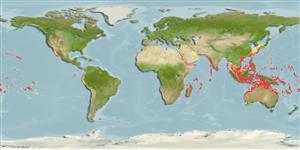Common names from other countries
Environment: milieu / climate zone / depth range / distribution range
Οικολογία
; εύρος βάθους 0 - 90 m (Ref. 81020). Tropical
Indo-Pacific: from Indian Ocean Tahiti and from Japan to South Pacific Islands.
Length at first maturity / Μέγεθος / Βάρος / Age
Maturity: Lm ? range ? - ? cm Max length : 15.0 cm WD αρσενικό/απροσδιόριστο; (Ref. 800)
Reported to have the broadest range of color morphs in the family Diadematidae (Ref. 2932). Most common color morphs throughout Indo-Pacific were the white (inerambulacral spines) and brown (test and ambulacral spines) and the completely brown color morph (Ref. 2929).
Inhabits shallow coral and coral rubble areas at depths of 1 to 40 m (Ref. 800). Feeds on algae (Ref. 2938).
Life cycle and mating behavior
Γεννητική Ωρίμανση | Αναπαραγωγή | Γεννοβολία | Αβγά | Γονιμότητα | Προνύμφες
Members of the class Echinoidea are gonochoric. Fertilization is external. Brooding is common, eggs are held either on the peristome, around the periproct or deep into the concavities on the petaloids. Life cycle: Embryos develop into planktotrophic larvae (echinoplateus) and live for several months before they sink to the bottom using their tube feet to adhere on the ground where they metamorphose into young urchins.
Schoppe, S. 2000. (Ref. 800)
IUCN Red List Status (Ref. 130435)
CITES status (Ref. 108899)
Not Evaluated
Not Evaluated
Threat to humans
Harmless
Human uses
αλιεία: Εμπορικό(ά)
| FishSource | Η θάλασσα γύρω μας
Εργαλεία
Διαδικτυακές πηγές
Estimates based on models
Preferred temperature
(Ref.
115969): 24.3 - 28.9, mean 27.6 (based on 926 cells).
Vulnerability
Low vulnerability (10 of 100).
Price category
Unknown.
